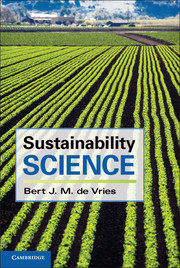Book contents
- Frontmatter
- Contents
- Preface
- 1 Introduction
- 2 The System Dynamics Perspective
- 3 In Search of Sustainability: Past Civilisations
- 4 The World in the Past 300 Years: The Great Acceleration
- 5 Sustainability: Concerns, Definitions, Indicators
- 6 Quality of Life: On Values, Knowledge and Worldviews
- 7 Energy Fundamentals
- 8 On Knowledge and Models
- 9 Land and Nature
- 10 Human Populations and Human Behaviour
- 11 Agro-Food Systems
- 12 Renewable Resources: Water, Fish and Forest
- 13 Non-Renewable Resources: The Industrial Economy
- 14 Towards a Sustainable Economy?
- 15 Outlook on Futures
- Glossary
- References
- Index
- Plate Section
- References
8 - On Knowledge and Models
Published online by Cambridge University Press: 05 January 2013
- Frontmatter
- Contents
- Preface
- 1 Introduction
- 2 The System Dynamics Perspective
- 3 In Search of Sustainability: Past Civilisations
- 4 The World in the Past 300 Years: The Great Acceleration
- 5 Sustainability: Concerns, Definitions, Indicators
- 6 Quality of Life: On Values, Knowledge and Worldviews
- 7 Energy Fundamentals
- 8 On Knowledge and Models
- 9 Land and Nature
- 10 Human Populations and Human Behaviour
- 11 Agro-Food Systems
- 12 Renewable Resources: Water, Fish and Forest
- 13 Non-Renewable Resources: The Industrial Economy
- 14 Towards a Sustainable Economy?
- 15 Outlook on Futures
- Glossary
- References
- Index
- Plate Section
- References
Summary
Introduction
Sustainability science: The word science suggests pursuit of ‘scientific knowledge’. But what is scientific knowledge? Let us have a closer look at what the acquisition of scientific knowledge is in practice. Suppose you are concerned about air pollution and set up an experiment to measure the concentration of substance X in a well-defined area. The measuring tool is itself a specimen of scientific development. The result of your experiment is a series of concentration values at given location p and time t, c(p,t). Building upon atmospheric physics and chemistry, you interpret the results in terms of dynamic cause-and-effect processes. Such a description, framed in the formal language of mathematics, is called a scientific model.
You realise that it is actually the impact of air pollution that matters, so you decide to explore impact on the forest in the area. With the help of ecologists, you do additional experiments and extend the model. The concentration values c(p,t) are now inputs to descriptions of the various trees in the forest. They are a measure of the exposure of the simulated trees to external factors. Because the tree dynamics are relatively slow, longitudinal experiments have to be set up (>5 years). The result of these experiments are an indication of the sensitivity of the various trees for the particular exposure c(p,t).
- Type
- Chapter
- Information
- Sustainability Science , pp. 215 - 243Publisher: Cambridge University PressPrint publication year: 2012



